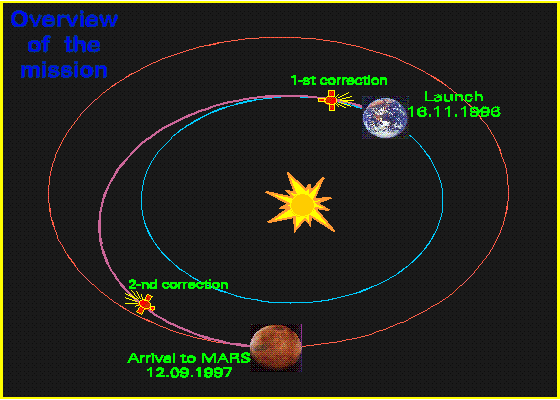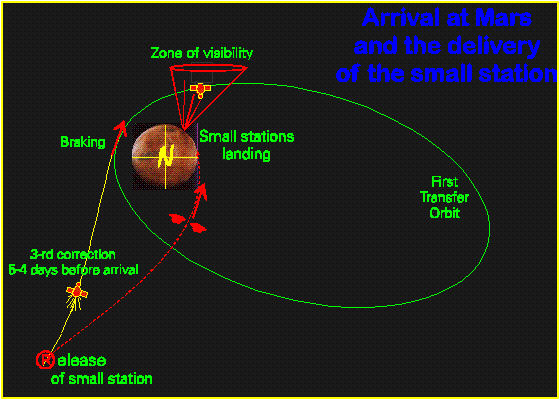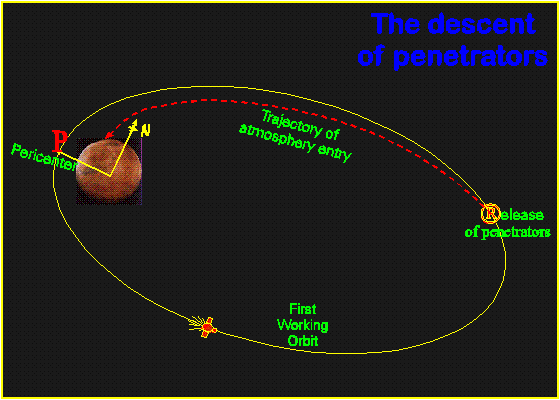Mars '96 is a Russian mission to Mars scheduled to be launched
in November/December 1996. The spacecraft (S/C) consists of an
orbiter and four landers (two small, moderately soft landers and two
penetrators). Only a single S/C will be launched during this
opportunity. The mission consists of seven phases: launch and
injection towards Mars, cruise (including 2 midcourse corrections),
small station release and orbiter deflection maneuver, orbit
insertion, orbit corrections, penetrator release, and mapping
operations.
Mars '96 is scheduled to launch in late November 1996 from the
Baikonur Cosmodrome. The first three stages and the first firing of
the fourth stage of the Proton launch vehicle will be used to
place the S/C into a 165 km, 51.6° inclined orbit. At the end of
the first orbit, the fourth stage will be reignited to provide 3150
m/sec of the required 3725 m/sec necessary for Trans-Mars Injection
(TMI). The remaining 575 m/sec needed to inject the 6 metric ton
vehicle on its trajectory to Mars will be provided by the S/C
propulsion module. Antenna deployments will occur between the 4th
stage and S/C burns; solar array and PAIS platform deployments will
occur after TMI.

Mars '96 will follow a Type-2 interplanetary trajectory to Mars.
After about 10 months in transit, arrival is scheduled for 12
September 1997. Two midcourse corrections are planned: the first
after 7-10 days, the second about one month before arrival at Mars.
Total anticipated Delta-V is less than 35 m/sec. A third correction
will occur in conjunction with the orbiter deflection maneuver about
4-5 days prior to Mars Orbit Insertion (MOI).
Approximately five days prior to MOI, the two small stations will be
jettisoned, and the Orbiter will perform a deflection maneuver of
about 35 m/s to place it on a trajectory to enter Mars orbit. The two
stations will approach Mars independently. Their atmospheric entry
velocity will be < 5.75 km/s, their entry angles between 10.5°
and 20.5° , and their entry azimuth between 115° and 145°
. Their landing site dispersion ellipses are ± 10° (600 km)
along track and ± 2° (120 km) cross-track. All candidate
landing sites are situated on the day-side of Mars, in Arcadia
Planitia. The primary sites are 41.31° N, 153.77° W and
32.48° N, 169.32° W. A backup site has been identified at
3.65° N, 193° W.

At the periapsis of the approach hyperbola, the S/C propulsion system
will be autonomously fired to place the the Orbiter into an initial
orbit with a period of 43.09 ± 8.5 hr, and periapsis and apoapsis
altitudes of 500 ± 200 and 52,000 km, respectively. Initial orbit
inclination is 106.4° , and the latitude of periapsis is 26°
North. The MOI Delta-V is 1020 m/sec.
Following MOI, the periapsis altitude will be adjusted to 300 km.
Several additional orbit maneuvers, taking between 7 and 28 days, will
be performed to phase the orbit for communications to Earth.
Owing to the possible dispersions in the initial orbital period, the
date for penetrator release may vary from 7 to 28 days. After the
orbit is adjusted for communications with the Earth, the intent is to
deploy one of the penetrators close to the small stations, and the
other at a greater distance (at least 90° in longitude). If,
however, the orbit phasing takes longer than expected, or dust storms
begin, both penetrators can be deployed during the same
telecommunications pass with the Earth. Under this condition, the
separation of the penetrators will be less (5-6° ).
For deployment, the Orbiter will first be properly oriented. The
penetrator to be released will be spun about its longitudinal axis for
stability and ejected. The penetrator's solid rocket motor will be
ignited after moving a safe distance away from the Orbiter; the burn
will place the penetrator into a atmospheric entry trajectory. Entry
occurs 21-22 hours later. It is possible to deploy both penetrators
on a single orbit. In the martian atmosphere, the probes undergo
aerodynamic braking, first using a rigid cone and then an air-inflated
braking device, until a given velocity is reached to provide their
penetration into martian regolith. The entry velocity is 4.9 km/s at
an entry angle of 12± 2°. The landing site error ellipse is
± 4° (240 km) along-track and ± 0.5° (30 km)
cross-track. The penetrator impacts the surface at a velocity of 80
± 20 m/s and the forebody separates from the aftbody. The
penetrating part of the probe forebody, carrying the scientific and
housekeeping instrumentation, enters the regolith down to 5-6 m, while
the aftbody, with the rest of the instrumentation, remains on the
surface. Scientific studies begin after penetration. Data are
relayed to Earth by the Orbiter.

The orbital operations phase of the mission includes two sub-phases:
support for the landed packages and orbital mapping. The orbital
period will be adjusted to permit relay of the lander data. The
orbital period permits 5-6 minute relays every seven days. Orbit
corrections of about ± 0.07 m/sec (± 1.8 minutes orbital
period or ± 110 km in groundtrack position) will be performed once a
month to maintain the communications link with the landers.
Once the penetrators have landed, the S/C propulsion module will be
jettisoned and the ARGUS science platform deployed. After 50-60 days,
the orbit periapsis will precess into the illuminated portion of Mars,
and the Orbiter's surface and atmosphere instruments will be used
extensively. The best illumination conditions will be encountered
about 90 days in orbit. At this time, the orbital period will be
adjusted to permit a 1° shift of ground tracks every 4 days.
After this adjustment, the Orbiter will not be able to view the
landers for data relay. Six additional orbit corrections are budgeted
for orbit sustenance (Delta-V < 45 m/sec).
The Mars 96 orbit periapsis migrates from 25° to 55° North
latitude over a 24 month period. Periapsis migrates from a sun
elevation angle of -25° to +38° for the first 8 months of the
mission, and then decreases for the next 16 months.
Tracking from the Evapatoria and Ussurijsk facilities varies from a
maximum of around 8 hrs (angle > 7° ) to about 6.5 hr two months
after MOI. Joint visibility decreases from 1.5 hr to 0.1 hr during
this time.
Solar conjunction occurs in May 1998:
Sun-Mars-Earth angle Dates
< 2 1-26 May
< 1 8-20 May
<0.1 13-14 May
After the Orbiter completes its primary mission, aerobraking will be
used to attempt to lower the orbital period from 43 to 8-10 hours.




 Return to MSSS
Home Page
Return to MSSS
Home Page